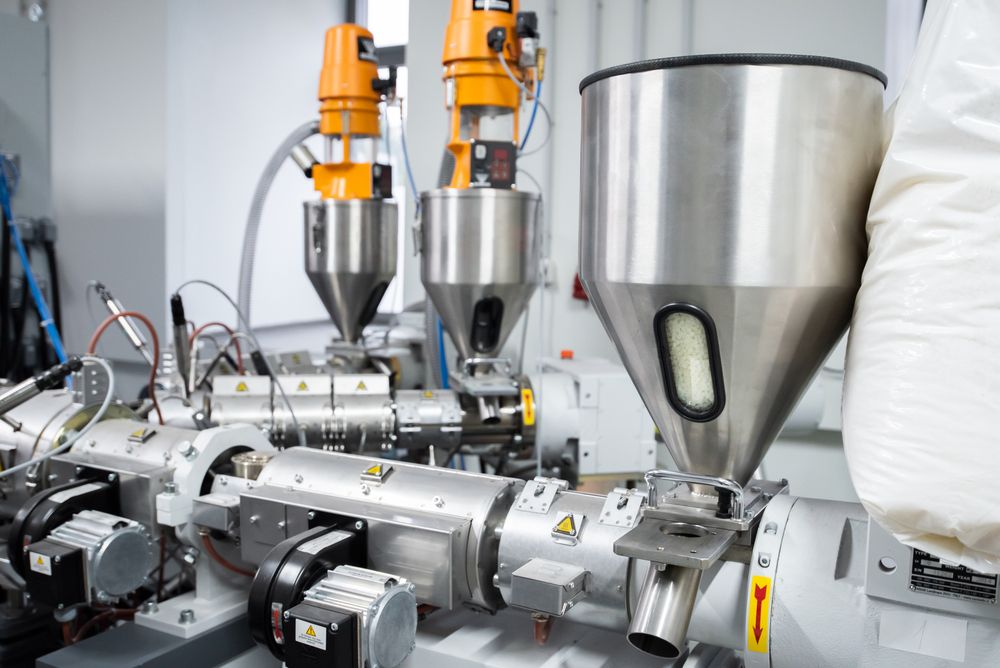Advanced Search
Results 2121 - 2131 of 2131
LD2426F
LD1826L
Why Purging Procedures are Necessary?
The Benefits of Having Proper Puring Procedures
Maintaining equipment efficiency and product quality is essential in the extrusion process. Purging is a critical maintenance procedure necessary for optimal performance and high-quality output. In this article, we’ll cover what purging is , its purpose, the different purging procedures, and the benefits of using purging compounds . We’ll also discuss why GC is your go-to provider for high-quality purging compounds.

What is Plastic Injection?
Plastic injection is a process used to create objects by injecting molten plastic material into a mold. It is commonly used in the plastics industry to produce parts of various shapes and sizes, from small components to large panels. The plastic material is typically melted and forced into a mold cavity, where it cools and hardens to form the final product.
What is Plastic Injection Machine?
A plastic injection machine, also known as an injection molding machine, is the main equipment used in the injection molding process. Injection molding machines are used to manufacture products across various industries, including consumer goods, electronics, and automotive. The injection molding machine consists of several key parts:
● Hopper: Where the raw material (usually in pellet or powder form) is loaded
● Barrel: The heated chamber where the material is melted
● Screw: A rotating screw that pushes the material forward and helps melt it through friction
● Injection Unit: The system that forces the molten plastic into the mold
● Mold: The cavity that shapes the plastic into the desired form
● Clamping System: Used to hold the mold closed against the pressure of injection
What is Puring in Plastic Injection?
Purging in plastic injection involves cleaning the injection molding machines to remove residual material and contaminants. Leftover material can degrade over time, leading to contamination, defects, and inconsistent product quality. Purging ensures that the equipment is clean and ready for the next production run, maintaining the integrity and performance of the injection molding machine.
What is the Purpose of Puring?
Purging is a procedure that serves several essential purposes in the injection process:
● Preventing Contamination: Residual material can cause contamination, leading to defective products. Purging removes these contaminants, ensuring product consistency and quality.
● Maintaining Product Quality: Purging helps maintain the quality of the products being produced by removing degraded materials and contaminants. Consistent and thorough purging results in higher product quality and fewer defects.
● Extending Equipment Life: Regular purging prevents the build-up of materials that can cause wear and tear on the equipment, thereby extending its lifespan and reducing the need for costly repairs.
● Reducing Downtime: Effective purging minimizes the need for frequent equipment repairs and maintenance, leading to less downtime and higher productivity.
How is Purging Done?
Purging procedures can be done in various ways, each suited to different types of contaminants and equipment conditions. The main methods include:
● Mechanical Purging: This uses purging compounds that physically scrub the interior surfaces of the extruder. These compounds are designed to be highly effective at removing stubborn residues without damaging the equipment.
● Chemical Purging: Chemical agents are used to break down and dissolve residual materials. This method is particularly effective for removing specific types of contaminants that are difficult to dislodge mechanically.
● Manual Purging: Involves disassembling parts of the extruder and manually cleaning them. This method is labor-intensive and typically used for thorough cleaning when switching between significantly different materials.
Benefits of Using Puring Material

Purging compound materials can be used for both injection and extrusion machines. They’re designed to reduce the time and power required for cleaning, making the process more efficient and cost-effective. Using purging materials in the extrusion process offers numerous benefits, including time savings, since purging compounds expedite the cleaning process and reduce the downtime between production runs. This allows for more efficient use of equipment and resources.
Speaking of cost efficiency, purging materials also reduce the labor needed for cleaning, which helps lower operational costs. They also minimize material waste. Since effective purging is quicker and requires less energy, the cleaning process requires lower energy consumption. Additionally, purging compounds can be used in various extrusion machines and for different materials, making them a flexible solution for maintaining equipment cleanliness.
X PURGE by GC Cleaning Compounds Maximize Cost Efficiency Across the Board
1. Reducing Production Time: Time is perhaps the most crucial cost consideration in production. X PURGE by GC has been proven to reduce machine cleaning time by more than 50% when compared to conventional purging solutions. These maintenance time savings can then be used to increase production time whike reducing labor costs.
2. Raw Materials and Energy: When compared to a standard purging solution, X PURGE by GC is 70% more efficient in terms of amount needed per cleaning, which also reduces waste material produced.. Further, its faster cleaning time reduces total energy consumption.
3. Machine Maintenance: X PURGE by GC is cleaning efficacy helps extend machine lifespan by reducing maintenance frequency, lowering long-term costs for replacement parts, and reducing the risk of machine breakdowns.
Overall, using X PURGE by GC creates widespread cost-saving value that is proven to increase profitability for its users by using those savings and investing in areas such as increasing production capacity, reducing long-term production costs, and improving machine output (product) quality.
Tips on Best Puring Practices
● Regular Maintenance Schedule: Establish a regular purging schedule to prevent the build-up of contaminants.
● Choose the Right Purging Compound: Select a purging compound suitable for the materials you are processing and the specific needs of your equipment.
● Follow Manufacturer Guidelines: Always follow the manufacturer’s guidelines for the purging process to ensure safety and effectiveness.
● Monitor and Document: Keep records of purging activities to monitor their effectiveness and make adjustments as needed.
High-Quanlity Puring Compounds
GC offers a range of high-quality purging compounds formulated to effectively remove contaminants and maintain the efficiency and performance of your extruder and molding machines. GC offers several types of purging compounds to meet different needs:
For general purpose: X PURGE GX168 is ideal for general-purpose cleaning and effectively removes a wide range of contaminants from the extruder. It’s tailor-made for cleaning various machines, including injection and extrusion machines, such as blow molding, sheet casting, and profile extrusion.
For high heat-resistance: X PURGE EX20T is designed for more specific applications with a temperature range from 200 - 340 °C. It provides superior cleaning for high-performance materials and is recommended for PP, PS ABS, PC, and nylon materials.
For high performance: X PURGE PX319 is a new grade known for its benefits as a purging compound. It’s used for its exceptional efficiency and quick and thorough purging cleaning injection machines for cold and hot runners. It’s designed for temperature ranges from 200 – 290 °C and is applicable for PE, POM, PP, ABS, and PA6 + glass fiber materials.
X PURGE by GC is more than just an ordinary plastic injection molding cleaning compound - it’s an efficient solution that helps increase competitiveness through systematic cost reduction. and endorsed by users in 38 countries worldwide. X PURGE’s advantages have proven to be a worthwhile investment for entrepreneurs looking to increase profitability by optimizing the maintenance procedures.
Implement effective purging procedures to maintain the efficiency and quality of your extrusion processes. Contact GC for innovative purging compound solutions for superior extrusion equipment performance. For more information, visit our purging compound page. https://productsandsolutions.pttgcgroup.com/xpurge/en
LL6420A
LL6428A
HD00108WBK
HD4010W
HD010WB
mPE
Metallocence Low Density Polyethylene (mLLDPE)
InnoPlus by GC Metallocene Polyethylene (mPE) has total production capacity at 300,000 MTA. Produced by low pressure polymerization, using gas phase of Unipol Process under the license of Univation Technology who is leading global technology licernsor of proven metallocence PE technology. These unconventional mPE from variety of catalyst offer a superior puncture and draft impact resistance, good seal ability and excellenct optical property. InnoPlus mPE is widely used for cast and blown film application.
mPE
Metallocence Low Density Polyethylene (mLLDPE)
InnoPlus by GC Metallocene Polyethylene (mPE) has total production capacity at 300,000 MTA. Produced by low pressure polymerization, using gas phase of Unipol Process under the license of Univation Technology who is leading global technology licernsor of proven metallocence PE technology. These unconventional mPE from variety of catalyst offer a superior puncture and draft impact resistance, good seal ability and excellenct optical property. InnoPlus mPE is widely used for cast and blown film application.
mPE
Metallocene Polyethylene (mPE)
InnoPlus by GC Metallocene Polyethylene (mPE) has total production capacity at 300,000 MTA. Produced by low pressure polymerization, using gas phase of Unipol Process under the license of Univation Technology who is leading global technology licernsor of proven metallocence PE technology. These unconventional mPE from variety of catalyst offer a superior puncture and draft impact resistance, good seal ability and excellenct optical property. InnoPlus mPE is widely used for cast and blown film application.


